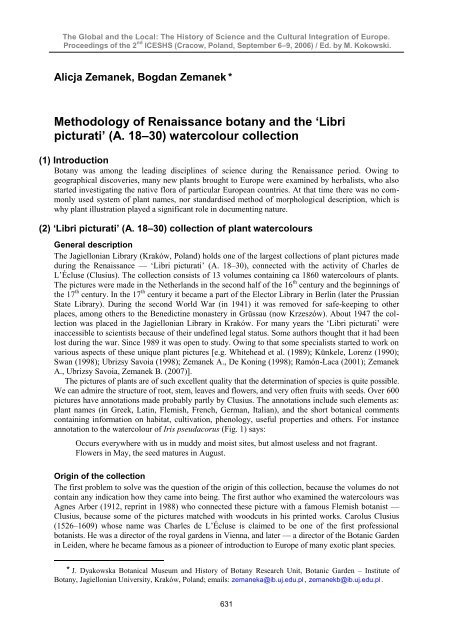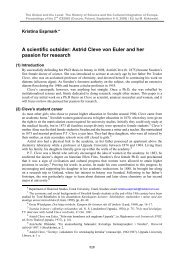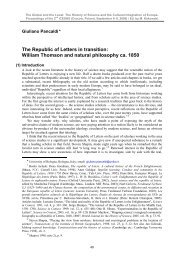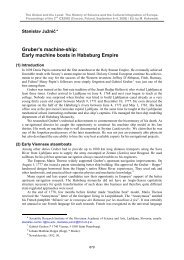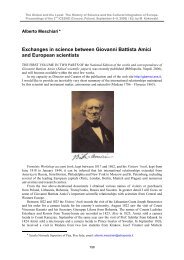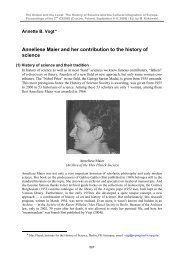Methodology of Renaissance botany and the 'Libri picturati' (A. 18 ...
Methodology of Renaissance botany and the 'Libri picturati' (A. 18 ...
Methodology of Renaissance botany and the 'Libri picturati' (A. 18 ...
Create successful ePaper yourself
Turn your PDF publications into a flip-book with our unique Google optimized e-Paper software.
The Global <strong>and</strong> <strong>the</strong> Local: The History <strong>of</strong> Science <strong>and</strong> <strong>the</strong> Cultural Integration <strong>of</strong> Europe.<br />
Proceedings <strong>of</strong> <strong>the</strong> 2 nd ICESHS (Cracow, Pol<strong>and</strong>, September 6–9, 2006) / Ed. by M. Kokowski.<br />
Alicja Zemanek, Bogdan Zemanek *<br />
<strong>Methodology</strong> <strong>of</strong> <strong>Renaissance</strong> <strong>botany</strong> <strong>and</strong> <strong>the</strong> ‘Libri<br />
picturati’ (A. <strong>18</strong>–30) watercolour collection<br />
(1) Introduction<br />
Botany was among <strong>the</strong> leading disciplines <strong>of</strong> science during <strong>the</strong> <strong>Renaissance</strong> period. Owing to<br />
geographical discoveries, many new plants brought to Europe were examined by herbalists, who also<br />
started investigating <strong>the</strong> native flora <strong>of</strong> particular European countries. At that time <strong>the</strong>re was no commonly<br />
used system <strong>of</strong> plant names, nor st<strong>and</strong>ardised method <strong>of</strong> morphological description, which is<br />
why plant illustration played a significant role in documenting nature.<br />
(2) ‘Libri picturati’ (A. <strong>18</strong>–30) collection <strong>of</strong> plant watercolours<br />
General description<br />
The Jagiellonian Library (Kraków, Pol<strong>and</strong>) holds one <strong>of</strong> <strong>the</strong> largest collections <strong>of</strong> plant pictures made<br />
during <strong>the</strong> <strong>Renaissance</strong> — ‗Libri picturati‘ (A. <strong>18</strong>–30), connected with <strong>the</strong> activity <strong>of</strong> Charles de<br />
L‘Écluse (Clusius). The collection consists <strong>of</strong> 13 volumes containing ca <strong>18</strong>60 watercolours <strong>of</strong> plants.<br />
The pictures were made in <strong>the</strong> Ne<strong>the</strong>rl<strong>and</strong>s in <strong>the</strong> second half <strong>of</strong> <strong>the</strong> 16 th century <strong>and</strong> <strong>the</strong> beginnings <strong>of</strong><br />
<strong>the</strong> 17 th century. In <strong>the</strong> 17 th century it became a part <strong>of</strong> <strong>the</strong> Elector Library in Berlin (later <strong>the</strong> Prussian<br />
State Library). During <strong>the</strong> second World War (in 1941) it was removed for safe-keeping to o<strong>the</strong>r<br />
places, among o<strong>the</strong>rs to <strong>the</strong> Benedictine monastery in Grüssau (now Krzeszów). About 1947 <strong>the</strong> collection<br />
was placed in <strong>the</strong> Jagiellonian Library in Kraków. For many years <strong>the</strong> ‗Libri picturati‘ were<br />
inaccessible to scientists because <strong>of</strong> <strong>the</strong>ir undefined legal status. Some authors thought that it had been<br />
lost during <strong>the</strong> war. Since 1989 it was open to study. Owing to that some specialists started to work on<br />
various aspects <strong>of</strong> <strong>the</strong>se unique plant pictures [e.g. Whitehead et al. (1989); Künkele, Lorenz (1990);<br />
Swan (1998); Ubrizsy Savoia (1998); Zemanek A., De Koning (1998); Ramón-Laca (2001); Zemanek<br />
A., Ubrizsy Savoia, Zemanek B. (2007)].<br />
The pictures <strong>of</strong> plants are <strong>of</strong> such excellent quality that <strong>the</strong> determination <strong>of</strong> species is quite possible.<br />
We can admire <strong>the</strong> structure <strong>of</strong> root, stem, leaves <strong>and</strong> flowers, <strong>and</strong> very <strong>of</strong>ten fruits with seeds. Over 600<br />
pictures have annotations made probably partly by Clusius. The annotations include such elements as:<br />
plant names (in Greek, Latin, Flemish, French, German, Italian), <strong>and</strong> <strong>the</strong> short botanical comments<br />
containing information on habitat, cultivation, phenology, useful properties <strong>and</strong> o<strong>the</strong>rs. For instance<br />
annotation to <strong>the</strong> watercolour <strong>of</strong> Iris pseudacorus (Fig. 1) says:<br />
Occurs everywhere with us in muddy <strong>and</strong> moist sites, but almost useless <strong>and</strong> not fragrant.<br />
Flowers in May, <strong>the</strong> seed matures in August.<br />
Origin <strong>of</strong> <strong>the</strong> collection<br />
The first problem to solve was <strong>the</strong> question <strong>of</strong> <strong>the</strong> origin <strong>of</strong> this collection, because <strong>the</strong> volumes do not<br />
contain any indication how <strong>the</strong>y came into being. The first author who examined <strong>the</strong> watercolours was<br />
Agnes Arber (1912, reprint in 1988) who connected <strong>the</strong>se picture with a famous Flemish botanist —<br />
Clusius, because some <strong>of</strong> <strong>the</strong> pictures matched with woodcuts in his printed works. Carolus Clusius<br />
(1526–1609) whose name was Charles de L‘Écluse is claimed to be one <strong>of</strong> <strong>the</strong> first pr<strong>of</strong>essional<br />
botanists. He was a director <strong>of</strong> <strong>the</strong> royal gardens in Vienna, <strong>and</strong> later — a director <strong>of</strong> <strong>the</strong> Botanic Garden<br />
in Leiden, where he became famous as a pioneer <strong>of</strong> introduction to Europe <strong>of</strong> many exotic plant species.<br />
* J. Dyakowska Botanical Museum <strong>and</strong> History <strong>of</strong> Botany Research Unit, Botanic Garden – Institute <strong>of</strong><br />
Botany, Jagiellonian University, Kraków, Pol<strong>and</strong>; emails: zemaneka@ib.uj.edu.pl , zemanekb@ib.uj.edu.pl .<br />
631
CHAPTER 20. / Symposium R-12.<br />
Changes <strong>of</strong> paradigms in biological sciences between <strong>Renaissance</strong> <strong>and</strong> modern times<br />
Fig. 1. Yellow flag (Iris pseudacorus)<br />
In 2003 <strong>the</strong> ‗Libri picturati‘ project was started concerning interdisciplinary studies on this unique<br />
collection <strong>of</strong> plant pictures. In this project authors from five countries take part, with Dr Jan de Koning<br />
<strong>and</strong> Gerda Uffelen (Leiden) as <strong>the</strong> main editors. The project includes historical <strong>and</strong> botanical aspects<br />
<strong>of</strong> <strong>the</strong> collection (we do not deal with problems belonging to <strong>the</strong> art history). Owing to <strong>the</strong> efforts <strong>of</strong><br />
Helena Wille (1997), <strong>and</strong> Florike Egmont (2005) a riddle <strong>of</strong> <strong>the</strong> origin <strong>of</strong> <strong>the</strong> collection was solved.<br />
According to <strong>the</strong>ir studies <strong>the</strong> set <strong>of</strong> watercolours was a combined work by <strong>the</strong> painters, <strong>the</strong> plantlovers<br />
who sponsored <strong>the</strong> painting, <strong>and</strong> <strong>the</strong> botanists (among o<strong>the</strong>rs Clusius) who annotated <strong>the</strong><br />
pictures. Two groups <strong>of</strong> pictures were distinguished. First <strong>of</strong> <strong>the</strong>m was made ca 1564–1569 in <strong>the</strong><br />
castle Moerkerke (now in Belgium) to order <strong>of</strong> Karel van Sint Omaars — a rich plant-lover. Clusius<br />
who was a friend <strong>of</strong> Omaars, <strong>and</strong> spent some years in Moerkerke, probably supervised <strong>the</strong> painters <strong>and</strong><br />
made some annotations to <strong>the</strong> pictures. The second group <strong>of</strong> <strong>the</strong> watercolours was made later — at <strong>the</strong><br />
end <strong>of</strong> <strong>the</strong> 16 th century <strong>and</strong> <strong>the</strong> beginning <strong>of</strong> <strong>the</strong> 17 th century. After Omaars death <strong>the</strong> collection came<br />
to <strong>the</strong> possession <strong>of</strong> ano<strong>the</strong>r rich plant-lover, Karel van Arenberg, who supplemented <strong>the</strong> set <strong>of</strong><br />
watercolours by <strong>the</strong> purchase <strong>and</strong> exchanging some materials. Ano<strong>the</strong>r hypo<strong>the</strong>sis about <strong>the</strong> origin <strong>of</strong><br />
<strong>the</strong> collection put forward C. Swan (1998) who attributed <strong>the</strong> watercolours to Dirck Outgaertsz Cluyt<br />
(Theodorus Clutius), but this idea is less documented.<br />
(3) <strong>Methodology</strong> <strong>of</strong> <strong>Renaissance</strong> <strong>botany</strong> <strong>and</strong> <strong>the</strong> ‘Libri picturati’ (A. <strong>18</strong>–30)<br />
Features <strong>of</strong> <strong>the</strong> old style <strong>of</strong> thinking<br />
One <strong>of</strong> <strong>the</strong> most interesting problems <strong>of</strong> <strong>the</strong> history <strong>of</strong> science is emerging new ideas <strong>and</strong> competition<br />
between old <strong>and</strong> new paradigms in scientific works. From this point <strong>of</strong> view <strong>the</strong> collection ‗Libri<br />
picturati‘ is fascinating, because coexistence <strong>of</strong> <strong>the</strong> old <strong>and</strong> new style <strong>of</strong> thinking in <strong>botany</strong> could be<br />
noticed. To <strong>the</strong> old paradigm belong: quotations <strong>of</strong> ancient authors — mainly Dioscorides, Plinius,<br />
Galen, Theophrastus; special attention to underground plant organs; <strong>the</strong> manner <strong>of</strong> flower depicting;<br />
<strong>and</strong> superstitions about plants (but very few <strong>of</strong> <strong>the</strong>m).<br />
In <strong>the</strong> ancient <strong>and</strong> medieval times <strong>the</strong> roots were <strong>of</strong> special interest because <strong>the</strong>y were used in<br />
medicine. The authors <strong>of</strong> <strong>the</strong> collection were interested in <strong>the</strong> underground plant organs as well.<br />
Maybe it is <strong>the</strong> sign <strong>of</strong> <strong>the</strong> old connection <strong>of</strong> <strong>botany</strong> with pharmacy. On <strong>the</strong> o<strong>the</strong>r side, <strong>the</strong> roots are<br />
presented very realistically — many types <strong>of</strong> underground parts <strong>of</strong> plants <strong>and</strong> <strong>the</strong>ir modifications are<br />
shown, for example storage thickened root in sweet potato. The presentation <strong>of</strong> flowers also bears <strong>the</strong><br />
features <strong>of</strong> <strong>the</strong> old style <strong>of</strong> thinking. Generally its shape <strong>and</strong> colour is painted perfectly, with artistic<br />
632
Alicja Zemanek, Bogdan Zemanek<br />
<strong>Methodology</strong> <strong>of</strong> <strong>Renaissance</strong> <strong>botany</strong> <strong>and</strong> <strong>the</strong> ‘Libri picturati’ (A. <strong>18</strong>–30) watercolour collection.<br />
skill — we can admire variety <strong>of</strong> forms <strong>and</strong> colours, but <strong>the</strong> internal structure <strong>of</strong> flower is almost<br />
always invisible.<br />
Fig. 2. Fragment <strong>of</strong> inflorescence <strong>of</strong> Fig. 3. Rose <strong>of</strong> Jericho<br />
heath spotted orchid (Dactylorhiza (Anastatica hierochuntica)<br />
maculata) with ‗smiling face‘<br />
The shape <strong>of</strong> zygomorphic corolla in orchids is generally depicted realistically, although under<br />
great magnification, we can notice a smiling face inside one flower <strong>of</strong> Dactylorhiza maculata (Fig. 2).<br />
It reminds interpretations <strong>of</strong> some herbalists, for instance H. Bock (Tragus) who tried to find anthropomorphic<br />
or zoomorphic structures in <strong>the</strong> orchid flowers. These interpretations are probably connected<br />
with <strong>the</strong> old usage <strong>of</strong> <strong>the</strong>se plants as aphrodisiacs. It should be underlined that sexual functions <strong>of</strong><br />
flowers were discovered at <strong>the</strong> end <strong>of</strong> <strong>the</strong> 17 th century (J. Camerarius, 1694).<br />
Generally, <strong>the</strong> authors <strong>of</strong> ‗Libri picturati‘ discarded old superstitions connected with plants. We<br />
have very few <strong>of</strong> <strong>the</strong>m. One <strong>of</strong> <strong>the</strong>m, with a critical comment, refers to <strong>the</strong> rose <strong>of</strong> Jericho (Anastatica<br />
hierochuntica) (Fig. 3) — a desert plant which dries up during <strong>the</strong> draught, <strong>and</strong> develops leaves<br />
immediately after watering. The annotation says:<br />
It opens not only during <strong>the</strong> Christmas Eve period, <strong>and</strong> not only on its own, as it was once<br />
believed by naïve local people, but always when you want it, after prior spraying it with<br />
water or wine.<br />
New currents<br />
The stock <strong>of</strong> watercolours in ‗Libri picturati‘ as a whole reflects <strong>the</strong> new currents in <strong>Renaissance</strong><br />
<strong>botany</strong>. Many <strong>of</strong> <strong>the</strong>se trends could be also seen in printed publication <strong>of</strong> that time, but <strong>the</strong> collection<br />
mirrors <strong>the</strong>m especially closely. These trends are: interest in plant morphology <strong>and</strong> variety <strong>of</strong> living<br />
forms, ecology, <strong>and</strong> geographical distributions <strong>of</strong> plants.<br />
Plant morphology dealing with <strong>the</strong> external structure <strong>of</strong> plants (appearance, shape <strong>and</strong> symmetry) is<br />
one <strong>of</strong> <strong>the</strong> oldest branches <strong>of</strong> <strong>botany</strong>. Its beginnings, in ancient times, were shaped by Theophrastus <strong>of</strong><br />
Eresus. In <strong>the</strong> <strong>Renaissance</strong> some authors <strong>of</strong> <strong>the</strong> printed works contributed a lot to <strong>the</strong> development <strong>of</strong><br />
morphology. In <strong>the</strong> ‗Libri picturati‘ we can find many morphological structures, maybe some <strong>of</strong> <strong>the</strong>m<br />
depicted for <strong>the</strong> first time. We have no morphological terms here. Only <strong>the</strong> picture, as universal language<br />
<strong>of</strong> information shows realistic view <strong>of</strong> particular plant organs, for example — many types <strong>of</strong> stem.<br />
Probably we have one <strong>of</strong> <strong>the</strong> first pictures <strong>of</strong> <strong>the</strong> root nodules in Papilionaceae (Fabaceae) family<br />
(Fig. 4). They were described for <strong>the</strong> first time almost hundred years later by Marcello Malpighi in his<br />
work Anatome Plantarum (1679). He observed <strong>the</strong> root nodules on <strong>the</strong> roots <strong>of</strong> broad bean (Vicia<br />
faba), <strong>and</strong> presumed that <strong>the</strong>y were caused by insects. The correct cause <strong>of</strong> <strong>the</strong> root nodules, symbiosis<br />
<strong>of</strong> papilionaceous plants with nitrogen fixing bacteria, was provided as late as in <strong>the</strong> 19 th century (e.g.<br />
Woronin <strong>18</strong>66).<br />
633
CHAPTER 20. / Symposium R-12.<br />
Changes <strong>of</strong> paradigms in biological sciences between <strong>Renaissance</strong> <strong>and</strong> modern times<br />
Fig. 4. Root nodules on <strong>the</strong> roots Fig. 5. ‗Plant monstrosity‘ — deformation<br />
<strong>of</strong> broad bean (Vicia faba) <strong>of</strong> apple fruits, fused in pairs<br />
At <strong>the</strong> end <strong>of</strong> <strong>Renaissance</strong> <strong>the</strong> interest in <strong>the</strong> curiosities <strong>of</strong> nature could be noticed. This fascination<br />
is mirrored in ‗Libri picturati‘. We have ca 40 examples <strong>of</strong> ‗monstrosities‘— atypical forms <strong>of</strong> plant<br />
organs, e.g. fasciated stem, multiplication <strong>of</strong> <strong>the</strong> number <strong>of</strong> flowers, deformation <strong>of</strong> apple fruits, fused<br />
in pairs (Fig. 5), etc.<br />
Ano<strong>the</strong>r new current very vital in <strong>Renaissance</strong> time was an interest in plant habitat <strong>and</strong> phenology.<br />
These problems we include now to plant ecology. The term ‗ecology‘ was introduced in <strong>the</strong> 19 th<br />
century (<strong>18</strong>66) by Ernst Haeckel.<br />
In <strong>the</strong> annotations to <strong>the</strong> pictures from <strong>the</strong> ‗Libri picturati‘ collection one can find many types <strong>of</strong><br />
ecological information. Some notes refer to relationships between plants <strong>and</strong> <strong>the</strong>ir environment,<br />
especially climate (insolation, humidity) <strong>and</strong> type <strong>of</strong> soil. The most abundant data concern <strong>the</strong> types <strong>of</strong><br />
habitats <strong>and</strong> species associated with <strong>the</strong>m. For 25 % <strong>of</strong> pictures we have also phenological information.<br />
Fig. 6. Sea-coast halophytes – Fig. 7. Ruderal species –<br />
glasswort (Salicornia europaea s.l.) nettle (Urtica dioica)<br />
<strong>and</strong> annual seablite (Suaeda maritima)<br />
As for <strong>the</strong> types <strong>of</strong> habitat <strong>the</strong> most abundant are plants <strong>of</strong> aquatic <strong>and</strong> wetl<strong>and</strong> sites. Very interesting<br />
is rare ecological group: sea-coast plants – halophytes (15 taxa). The annotation on one <strong>of</strong> <strong>the</strong> sheets<br />
with two species (Fig. 6) says:<br />
634
Alicja Zemanek, Bogdan Zemanek<br />
<strong>Methodology</strong> <strong>of</strong> <strong>Renaissance</strong> <strong>botany</strong> <strong>and</strong> <strong>the</strong> ‘Libri picturati’ (A. <strong>18</strong>–30) watercolour collection.<br />
They like very much salty soils <strong>and</strong> sea-coasts, <strong>and</strong> grow in stable union: to such degree<br />
that many people considered, wrongly, <strong>the</strong>re were not two, but one plant, <strong>and</strong> proposed<br />
such opinion.<br />
This information could be treated as early description <strong>of</strong> plant community. Many centuries later<br />
J. Braun-Blanquet described in Languedoc <strong>the</strong> similar type <strong>of</strong> association formed by o<strong>the</strong>r species.<br />
Fig. 8. Melon Fig. 9. Small tobacco<br />
(Cucumis melo) (Nicotiana rustica)<br />
Numerous notes pertains to <strong>the</strong> anthropogenic habitats, that is to say ruderal plants accompanying<br />
human settlements (Fig. 7), <strong>and</strong> segetal growing in <strong>the</strong> gardens <strong>and</strong> cultivated fields. It is <strong>the</strong> prove <strong>of</strong><br />
<strong>the</strong> changes <strong>of</strong> natural environment by man in <strong>the</strong> 16 th century in Western Europe. Some pictures have<br />
also <strong>the</strong> notes about <strong>the</strong> condition <strong>of</strong> particular species in cultivation. For example — melon (Cucumis<br />
melo) (Fig. 8):<br />
Likes sunny places, fertilized well, <strong>and</strong> soil tilled thoroughly. With us ripens in August<br />
<strong>and</strong> September, in warmer sites earlier.<br />
Phytogeography as separate discipline emerged at <strong>the</strong> beginnings <strong>of</strong> <strong>the</strong> 19 th century, owing to<br />
Alex<strong>and</strong>er von Humboldt‘s works, but many centuries earlier, in <strong>the</strong> <strong>Renaissance</strong>, some authors were<br />
interested in plants distribution. In ‗Libri picturati‘ phytogeographical information could be found in<br />
annotation to <strong>the</strong> species 146 times. The most numerous are <strong>the</strong> names from <strong>the</strong> Ne<strong>the</strong>rl<strong>and</strong>s (which<br />
confirms <strong>the</strong> hypo<strong>the</strong>sis <strong>of</strong> making <strong>the</strong> pictures in this country). Very large group are <strong>the</strong> Mediterranean<br />
species — especially from Iberian Peninsula, <strong>and</strong> Italy. Less numerous are names from Germany,<br />
Switzerl<strong>and</strong>, France, Britain, <strong>and</strong> Bohemia.<br />
The separate problems are <strong>the</strong> new species coming from various continents introduced to Europe in<br />
<strong>the</strong> 16 th. <strong>and</strong> <strong>the</strong> beginnings <strong>of</strong> <strong>the</strong> 17 th century. One <strong>of</strong> <strong>the</strong> first pictures in <strong>the</strong> world is that <strong>of</strong> Dracaena<br />
draco — exotic species coming from Canary Isl<strong>and</strong>s. Ano<strong>the</strong>r early presentation concerns Nicotiana<br />
rustica (Fig. 8) native <strong>of</strong> America.<br />
To sum up <strong>the</strong> ‗Libri picturati‘ collection it is not only beautiful ‗painted garden‘ joining <strong>the</strong> aims <strong>of</strong><br />
art <strong>and</strong> science, not only botanical documentation <strong>of</strong> <strong>the</strong> flora <strong>of</strong> Europe <strong>and</strong> <strong>of</strong> some plant introduction,<br />
but also an unique historical source showing us <strong>the</strong> <strong>Renaissance</strong> way <strong>of</strong> thinking about <strong>botany</strong>.<br />
635
CHAPTER 20. / Symposium R-12.<br />
Changes <strong>of</strong> paradigms in biological sciences between <strong>Renaissance</strong> <strong>and</strong> modern times<br />
(4) Acknowledgements<br />
We would like to thank Pr<strong>of</strong>essor Zdzisław Pietrzyk (Director <strong>of</strong> <strong>the</strong> Jagiellonian Library, Kraków) for<br />
permission to reproduce some <strong>of</strong> <strong>the</strong> ‗Libri picturati‘ watercolours. This paper was supported by State<br />
Committee for Scientific Research (Pol<strong>and</strong>), research project No 3 P04G11424.<br />
Literature<br />
Arber A. (1988): Herbals <strong>the</strong>ir origin <strong>and</strong> evolution A chapter in <strong>the</strong> history <strong>of</strong> <strong>botany</strong> 1470–1670.<br />
(Cambridge: Cambridge University Press), pp. XXXII + 358.<br />
Egmont F. (2005): ―Clusius, Cluyt, Saint Omer <strong>the</strong> origins <strong>of</strong> <strong>the</strong> sixteenth-century botanical <strong>and</strong> zoological<br />
watercolours in Libri picturati A. 16–30‖. Firenze, Leo S. Olschki Editore, pp. 67. Estratto da:<br />
Nuncius Journal <strong>of</strong> <strong>the</strong> History <strong>of</strong> Science 20(1).<br />
Künkele S., Lorenz R. (1990): ―Die Orchideen in dem Bilderwerk des Carolus Clusius (Libri picturati<br />
A.16–31)‖. Beiträge zur Geschichte der europäischen Orchideen im 16. Jahrhundert. AHO<br />
Mitteilungsblatt 22(3), p. 541–691.<br />
Ramón-Laca L. (2001): ―Charles de l‘Écluse <strong>and</strong> Libri picturati A. 16–30‖. Archives <strong>of</strong> Natural History<br />
28(2), p. 195–243.<br />
Swan C. (1998): The Clutius botanical watercolors. Plants <strong>and</strong> flowers <strong>of</strong> <strong>the</strong> <strong>Renaissance</strong>. (New York:<br />
Harry N. Abrams), pp. 144.<br />
Ubrizsy Savoia A. (1998): ―Environmental approach in <strong>the</strong> <strong>botany</strong> <strong>of</strong> <strong>the</strong> 16 th century‖. [In:] Mirek Z.,<br />
Zemanek, A. (Eds). Studies in <strong>Renaissance</strong> <strong>botany</strong>. Polish Botanical Studies, Guidebook Series 20<br />
(Kraków), p. 73–86.<br />
Whitehead P.J.P., Vliet van G., Stearn W.T. (1989): ―The Clusius <strong>and</strong> o<strong>the</strong>r natural history pictures in <strong>the</strong><br />
Jagiellonian Library‖, Archives <strong>of</strong> Natural History 16(1) (Kraków), p. 15–32 .<br />
Wille H. (1997): ―The albums <strong>of</strong> Karel van Sint Omaars (1533–1569) (Libri picturati A 16–31, in <strong>the</strong><br />
Jagiellonian Library in Krakow)‖. Archives <strong>of</strong> Natural History 24(3), p. 423–437.<br />
Zemanek A., De Koning J. (1998): ―Plant illustrations in <strong>the</strong> Libri picturati (A. <strong>18</strong>–30) (Jagiellonian Library,<br />
Cracow, Pol<strong>and</strong>) <strong>and</strong> new currents in <strong>Renaissance</strong> <strong>botany</strong>‖. [In:] Mirek Z., Zemanek, A. (Eds).<br />
Studies in <strong>Renaissance</strong> <strong>botany</strong>. Polish Botanical Studies, Guidebook Series 20 (Kraków), p. 161–193.<br />
Zemanek A., Ubrizsy Savoia A., Zemanek B. (2007): ―The beginnings <strong>of</strong> ecological thought in <strong>the</strong><br />
<strong>Renaissance</strong>: an account based on <strong>the</strong> Libri picturati A. <strong>18</strong>–30 collection <strong>of</strong> water-colours‖.<br />
Archives <strong>of</strong> Natural History 34(1), p. 87–108.<br />
636


